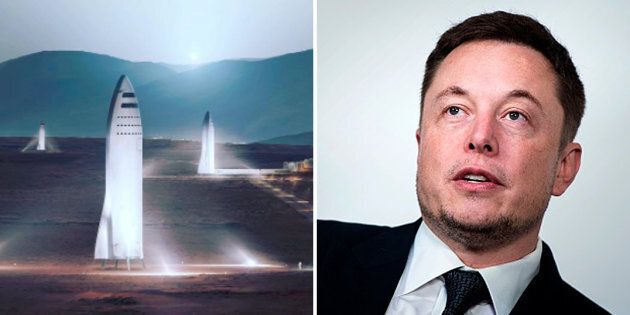
Entrepreneur Elon Musk unveiled his latest plans for a new space rocket on Friday that he says will see humans land on Mars by 2022.
Speaking to a packed auditorium in South Australia, Musk revealed designs for the code-named BFR rocket -- a 100-metre-tall space ship that is understood to cost less and have more launch power than anything the billionaire's space transport manufacturer body, SpaceX, has ever worked on before.
Further to that, he also said he believes he's found a way of funding such an optimistic venture -- by reusing the resources put into previous rocket ventures for this new plan.
"It is to have a smaller vehicle, still pretty big, but one that can serve -- one that can do everything that is needed in the greater Earth orbit activity," he said in a keynote presentation speech.
"Essentially, we want to make our current vehicles redundant. We want to have one system, one booster ship that replaces [previously planned SpaceX rockets] Falcon 9, Falcon Heavy and Dragon.
"If we can do that, then all the resources that are used for Falcon 9 Heavy and Dragon can be applied to this system so that is fundamental."
Musk also said the BFR, which is expected to start being constructed within the next six months, will have "the highest engine [capacity] of any kind ever made," and has successfully passed 42 engine-firing tests and 16 landing tests.
SpaceX is promising the rocket will be so powerful that -- in addition to its plans for Mars -- it will transport travellers from any location to another on Earth within an hour.
The plans for the rocket include a self-docking function, meaning that landing properly at a space station will require no human interaction from the rockets pilots, and the ship will have a fully reusable refuelling capacity that is aimed at saving on some of the cost and interplanetary travel time.
So, basically -- the promise of a smooth landing and less fuel stops along the way.
Additionally, the vehicle will have around 40 cabins for traveller groups of two or three people each, meaning about 100 people in total could be transported in a single launch.
"It is really quite a big vehicle. The main body diameter is about 9m or 30 feet. The booster is lifted by 31 rapture engines that thrust 5400 tonnes lifting a 34 tonne vehicle straight up," Musk said.
"That ship will contain 1100 tonnes propellant with a design of 150 tonnes and return mass of 50."
And if you thought that was a lot to take in, there's more.
Musk even released concept images of "Mars City" and "Moon Base Alpha" prior to his presentation to give excited space-lovers an idea of what the start of life on Mars might actually look like.
According to him, it will be the "opposite of Earth. Dawn and dusk sky are blue on Mars and day sky is red".
While the announcement comes just a fortnight after Musk uploaded a blooper reel of failed landing attempts with one of the other SpaceX rockets, Falcon 9, the billionaire really has been pushing the boundaries when it comes to unveiling things that go really, really fast.
And with his plans to achieve a self-sustaining human settlement on Mars now starting to look more realistic for the not-too-distant future, the BFR might just be the galactic answer to space travel that Earth has been looking for.
With that being said, Musk's plans were not the only Mars-related news to be announced on Friday, with US aerospace technology Lockheed Martin beating the entrepreneur to the punch, with its own details of a "Mars Base Camp".
The vision, which competes with Musk's designs, seeks to send humans to Mars within a decade to undertake scientific research and uncover the ideal circumstances for everyday people to land on the red planet by the 2030s.
"Mars Base Camp is Lockheed Martin's vision for sending humans to Mars in about a decade," a statement from the company said.
"The concept is simple: transport astronauts from Earth, via the Moon, to a Mars-orbiting science laboratory where they can perform real-time scientific exploration, analyse Martian rock and soil samples, and confirm the ideal place to land humans on the surface in the 2030s."
The idea also encompasses Lockheed's own Mars Lander spacecraft to ensure astronauts can venture onto Mars from the base station.
"Each surface mission could last two weeks with up to four astronauts, and return to the orbiting Mars Base Camp without surface refueling or leaving assets behind," the statement said.
And now the path to Mars comes down to whoever can build faster, cheaper, and smarter.